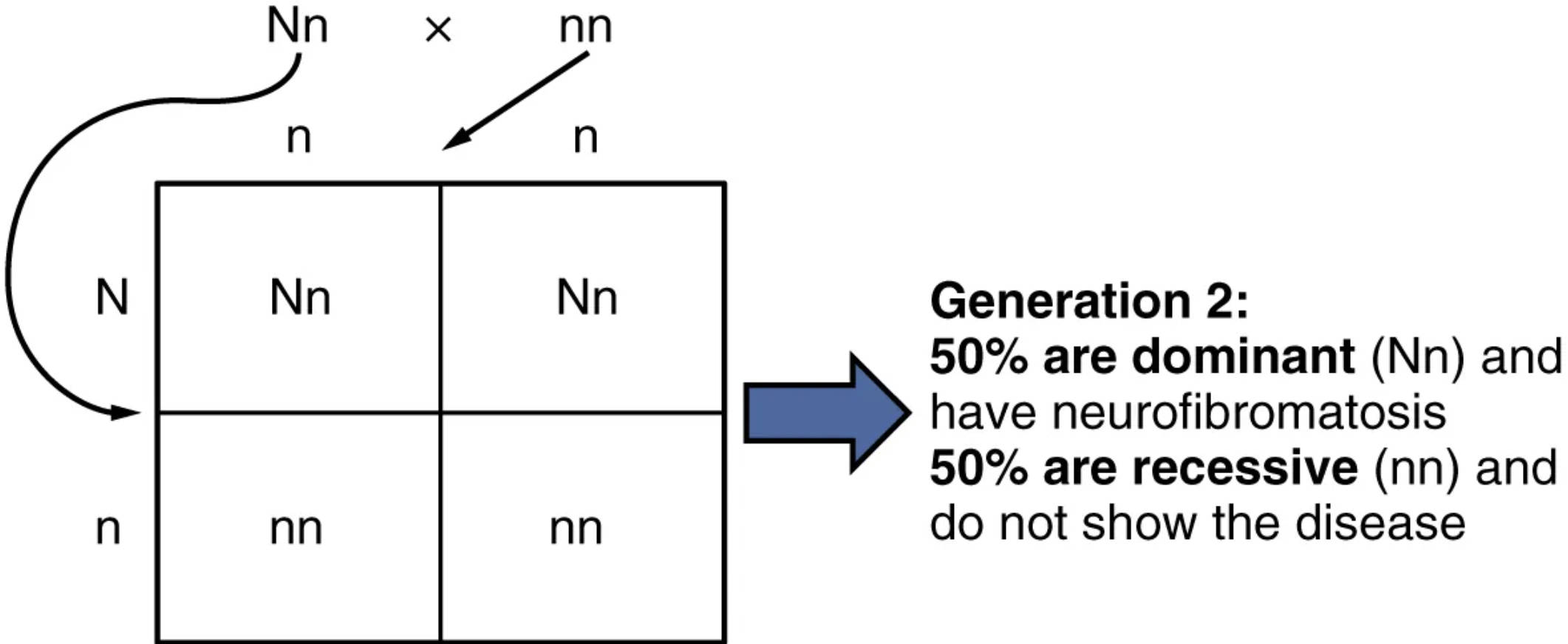This diagram vividly illustrates the inheritance pattern of an autosomal dominant disorder, using neurofibromatosis as a prime example. Through a Punnett square, it clearly demonstrates how a single copy of an affected gene is sufficient to cause the condition, highlighting the probabilities of inheritance when one parent is heterozygous for the disorder and the other is unaffected. This visual aid is crucial for comprehending the genetic basis and transmission risks of such conditions.

Nn x nn: This represents the genetic cross between two parents. One parent is heterozygous (Nn), meaning they carry one dominant allele (N) for the disorder and one recessive normal allele (n). This parent is affected by neurofibromatosis. The other parent is homozygous recessive (nn), meaning they carry two recessive normal alleles (n) and are therefore unaffected by the disorder.
Punnett Square: This 2×2 grid is a fundamental tool in genetics used to predict the genotypes of offspring from a genetic cross. The alleles from the heterozygous parent (N, n) are placed along one axis, and the alleles from the homozygous recessive parent (n, n) are placed along the other axis. Each of the four internal boxes represents a possible genotype for the offspring.
Offspring Genotypes (Nn, nn): The Punnett square shows two possible genotypes for the offspring: Nn and nn. The Nn genotype signifies offspring who are heterozygous and will inherit neurofibromatosis due to the dominant ‘N’ allele. The nn genotype signifies offspring who are homozygous recessive and will not inherit the disease.
Generation 2: 50% are dominant (Nn) and have neurofibromatosis, 50% are recessive (nn) and do not show the disease: This label summarizes the phenotypic and genotypic probabilities for the offspring of this particular cross. It indicates a 50% chance for offspring to inherit the dominant allele and thus develop neurofibromatosis, and a 50% chance for offspring to inherit two recessive alleles and be unaffected.
The provided diagram offers a clear and concise illustration of autosomal dominant inheritance, a fundamental pattern of genetic transmission. In this mode of inheritance, only one copy of an altered gene on a non-sex chromosome (an autosome) is sufficient to cause the disorder. The image specifically uses neurofibromatosis as an example, a condition that manifests when an individual inherits just one dominant allele for the disease. This visual representation is an invaluable tool for understanding how such genetic conditions are passed from one generation to the next and for predicting the likelihood of offspring being affected.
The core of the diagram is the Punnett square, a simple yet powerful genetic tool. It depicts a cross between two individuals: one who is heterozygous (Nn) for the autosomal dominant condition and thus affected, and another who is homozygous recessive (nn) and unaffected. The uppercase ‘N’ represents the dominant allele responsible for neurofibromatosis, while the lowercase ‘n’ represents the normal, recessive allele. When the heterozygous parent (Nn) produces gametes, there is an equal probability of passing on either the ‘N’ allele or the ‘n’ allele. Conversely, the unaffected parent (nn) can only pass on the ‘n’ allele.
The resulting distribution within the Punnett square reveals the probabilities for the offspring’s genotypes and phenotypes. As clearly indicated in “Generation 2,” there is a 50% chance that any offspring will inherit the ‘N’ allele from the affected parent, resulting in a heterozygous (Nn) genotype and the manifestation of neurofibromatosis. Conversely, there is also a 50% chance that an offspring will inherit the ‘n’ allele from the affected parent and an ‘n’ allele from the unaffected parent, leading to a homozygous recessive (nn) genotype and an unaffected status. This characteristic 50% transmission rate to offspring is a hallmark of autosomal dominant disorders and is crucial for genetic counseling.
Neurofibromatosis type 1 (NF1), the most common form, is a classic example of an autosomal dominant disorder. It is caused by a mutation in the NF1 gene located on chromosome 17. This gene codes for a protein called neurofibromin, which acts as a tumor suppressor. When the NF1 gene is mutated, the production of functional neurofibromin is disrupted, leading to uncontrolled cell growth and the development of benign tumors (neurofibromas) along nerves. Clinical manifestations of NF1 are highly variable, even within the same family, a phenomenon known as variable expressivity. Common symptoms include café-au-lait spots (light brown skin patches), axillary and inguinal freckling, Lisch nodules (benign iris hamartomas), and neurofibromas of varying sizes and locations.
The inheritance pattern illustrated in the diagram is critical for understanding the familial risk of NF1. If one parent has NF1 (Nn) and the other does not (nn), each child has a 50% chance of inheriting the mutated gene and subsequently developing the disorder. This applies regardless of the child’s sex. A key feature of autosomal dominant conditions is that affected individuals typically have at least one affected parent, though spontaneous new mutations can also occur. When a new mutation arises, an individual may be the first in their family to have the condition. Genetic testing can confirm the diagnosis and identify the specific mutation in the NF1 gene, which is particularly useful in cases of ambiguous presentation or for reproductive planning.
Genetic counseling plays a vital role for families affected by autosomal dominant conditions like neurofibromatosis. Understanding the 50% probability of transmission helps prospective parents make informed decisions about family planning. While the diagram simplifies the genetic mechanism, the clinical reality of NF1 involves careful management of its diverse symptoms, including regular monitoring for potential complications such as plexiform neurofibromas, optic pathway gliomas, and skeletal abnormalities. The study of such inheritance patterns is therefore not merely theoretical but directly impacts patient care and management strategies in clinical genetics.

